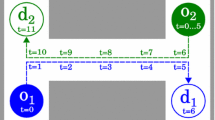Abstract
We consider the problem of optimal path planning in different homotopy classes in a given environment. Though important in robotics applications, path-planning with reasoning about homotopy classes of trajectories has typically focused on subsets of the Euclidean plane in the robotics literature. The problem of finding optimal trajectories in different homotopy classes in more general configuration spaces (or even characterizing the homotopy classes of such trajectories) can be difficult. In this paper we propose automated solutions to this problem in several general classes of configuration spaces by constructing presentations of fundamental groups and giving algorithms for solving the word problem in such groups. We present explicit results that apply to knot and link complements in 3-space, discuss how to extend to cylindrically-deleted coordination spaces of arbitrary dimension, and also present results in the coordination space of robots navigating on an Euclidean plane.
Similar content being viewed by others
References
Arslan, O., Guralnik, D.P., Koditschek, D.E.: Coordinated robot navigation via hierarchical clustering. IEEE Trans. Robot. 32(2), 352–371 (2016). ISSN 1552-3098
Bhattacharya, S., Kim, S., Heidarsson, H., Sukhatme, G., Kumar, V.: A topological approach to using cables to separate and manipulate sets of objects. International Journal of Robotics Research, online first publication. https://doi.org/10.1177/0278364914562236 (2015)
Bhattacharya, S., Ghrist, R.: Path homotopy invariants and their application to optimal trajectory planning. In: Proceedings of IMA Conference on Mathematics of Robotics (IMAMR), St Anne’s College, University of Oxford, September 9-11 (2015)
Bhattacharya, S., Likhachev, M., Kumar, V.: Topological constraints in search-based robot path planning. Autonom. Robots, 1–18. ISSN 0929-5593. https://doi.org/10.1007/s10514-012-9304-1 (2012)
Bhattacharya, S., Lipsky, D., Ghrist, R., Kumar, V.: Invariants for homology classes with application to optimal search and planning problem in robotics. Ann. Math. Artif. Intell. (AMAI) 67(3), 251–281 (2013). https://doi.org/10.1007/s10472-013-9357-7
Birman, J.S.: Braids, Links and Mapping Class Groups, vol. 82. Princeton University Press (1975)
Canny, J., Reif, J.H.: New lower bound techniques for robot motion planning problems. In: Proc. 28th Annu. IEEE Sympos. Found. Comput. Sci., pp. 49–60 (1987)
Cohen, D.C., Pruidze, G.: Motion planning in tori. Bull. Lond. Math. Soc. 40(2), 249–262 (2008). https://doi.org/10.1112/blms/bdn005
Cormen, T.H., Leiserson, C.E., Rivest, R.L., Stein, C.: Introduction to Algorithms, 2nd edn. MIT Press (2001)
Costa, A., Farber, M.: Motion planning in spaces with small fundamental groups. Commun. Contemp. Math. 12(01), 107–119 (2010). https://doi.org/10.1142/S0219199710003750
Crowell, R.H.: On the van kampen theorem. Pac. J. Math. 9(1), 43–50 (1959)
Demyen, D., Buro, M.: Efficient triangulation-based pathfinding. In: AAAI’06: Proceedings of the 21st National Conference on Artificial Intelligence, pp.ages 942–947. AAAI Press. ISBN 978-1-57735-281-5 (2006)
Epstein, D.B.A., Paterson, M.S., Cannon, J.W., Holt, D.F., Levy, S.V., Thurston, W.P.: Word Processing in Groups. Ak Peters Series Taylor & Francis (1992)
Fadell, E., Neuwirth, L.: Configuration Spaces Mathematica Scandinavica (1962)
Farber: Topological complexity of motion planning. Discret. Comput. Geom. 29 (2), 211–221 (2003). https://doi.org/10.1007/s00454-002-0760-9. ISSN 1432-0444
Farber, M., Grant, M., Yuzvinsky, S.: Topological complexity of collision free motion planning algorithms in the presence of multiple moving obstacles, pp. 75–83. Contemporary Mathematics. American Mathematical Society, United States. ISBN 978-0-8218-4246-1 (2007)
Ghrist, R., LaValle, S.: Nonpositive curvature and Pareto optimal motion planning. SIAM J. Control Optim. 45(5), 1697–1713 (2006)
Govindarajan, V., Bhattacharya, S., Kumar, V.: Human-robot collaborative topological exploration for search and rescue applications. In: International Symposium on Distributed Autonomous Robotic Systems (DARS) (2014)
Greendlinger, E., Greendlinger, M.: On Dehn presentations and Dehn algorithms. Illinois J. Math. 30(2), 360–363, 06 (1986)
Grigoriev, D., Slissenko, A.: Polytime algorithm for the shortest path in a homotopy class amidst semi-algebraic obstacles in the plane. In: ISSAC ’98: Proceedings of the 1998 International Symposium on Symbolic and Algebraic Computation, pp 17–24. ACM, New York (1998)
Hatcher, A.: Algebraic Topology. Cambridge Univ Press (2001)
Hershberger, J., Snoeyink, J.: Computing minimum length paths of a given homotopy class. Comput. Geom Theory Appl 4, 331–342 (1991)
Kim, S., Bhattacharya, S., Kumar, V.: Path planning for a tethered mobile robot. In: Proceedings of IEEE International Conference on Robotics and Automation. Hong Kong, China, May 31 - June 7 (2014)
Lickorish, W.B.R.: An Introduction to Knot Theory. Graduate Texts in Mathematics. Springer, New York (1997). ISBN 9780387982540
Lyndon, R.C., Schupp, P.E.: Combinatorial Group Theory. Classics in Mathematics. Springer, Berlin (2001). ISBN 9783540411581
Mitchell, J.S.B., Sharir, M.: New results on shortest paths in three dimensions. In: Proceedings of the Twentieth Annual Symposium on Computational Geometry, pp. 124–133. ACM (2004)
Niblo, G.A., Reeves, L.D.: The geometry of cube complexes and the complexity of their fundamental groups. Topology 37(3), 621–633 (1998)
Schmitzberger, E., Bouchet, J.L., Dufaut, M., Wolf, D., Husson, R.: Capture of homotopy classes with probabilistic road map. In: International Conference on Intelligent Robots and Systems, vol.3, pp. 2317–2322 (2002)
Scott, W.R., Scott, W.R.: Group Theory. Dover Books on Mathematics Series. Dover Publ. ISBN 9780486653778 (1964)
Tovar, B., Cohen, F., LaValle, S.M.: Sensor beams, obstacles, and possible paths. In: Workshop on the Algorithmic Foundations of Robotics, pp. 317–332 (2008)
Weinbaum, C.M.: The word and conjugacy problems for the knot group of any tame, prime, alternating knot. Proc. Amer. Math. Soc. 30(1), 22–26 (1971)
Acknowledgements
The authors acknowledge the support of federal contracts FA9550-12-1-0416 and FA9550-09-1-0643. The first author acknowledges the support of ONR grant number N00014-14-1-0510 and University of Pennsylvania subaward number 564436.
Author information
Authors and Affiliations
Corresponding author
Additional information
Parts of this paper has appeared in the proceedings of the IMA Conference on Mathematics of Robotics (IMAMR), 2015.
Electronic supplementary material
Below is the link to the electronic supplementary material.
(MOV 6.25 MB)
Rights and permissions
About this article
Cite this article
Bhattacharya, S., Ghrist, R. Path homotopy invariants and their application to optimal trajectory planning. Ann Math Artif Intell 84, 139–160 (2018). https://doi.org/10.1007/s10472-018-9596-8
Published:
Issue Date:
DOI: https://doi.org/10.1007/s10472-018-9596-8
Keywords
- Mathematical robotics
- Path homotopy invariants
- Knot and link complements
- Coordination spaces
- Graph search
- Topological path planning




